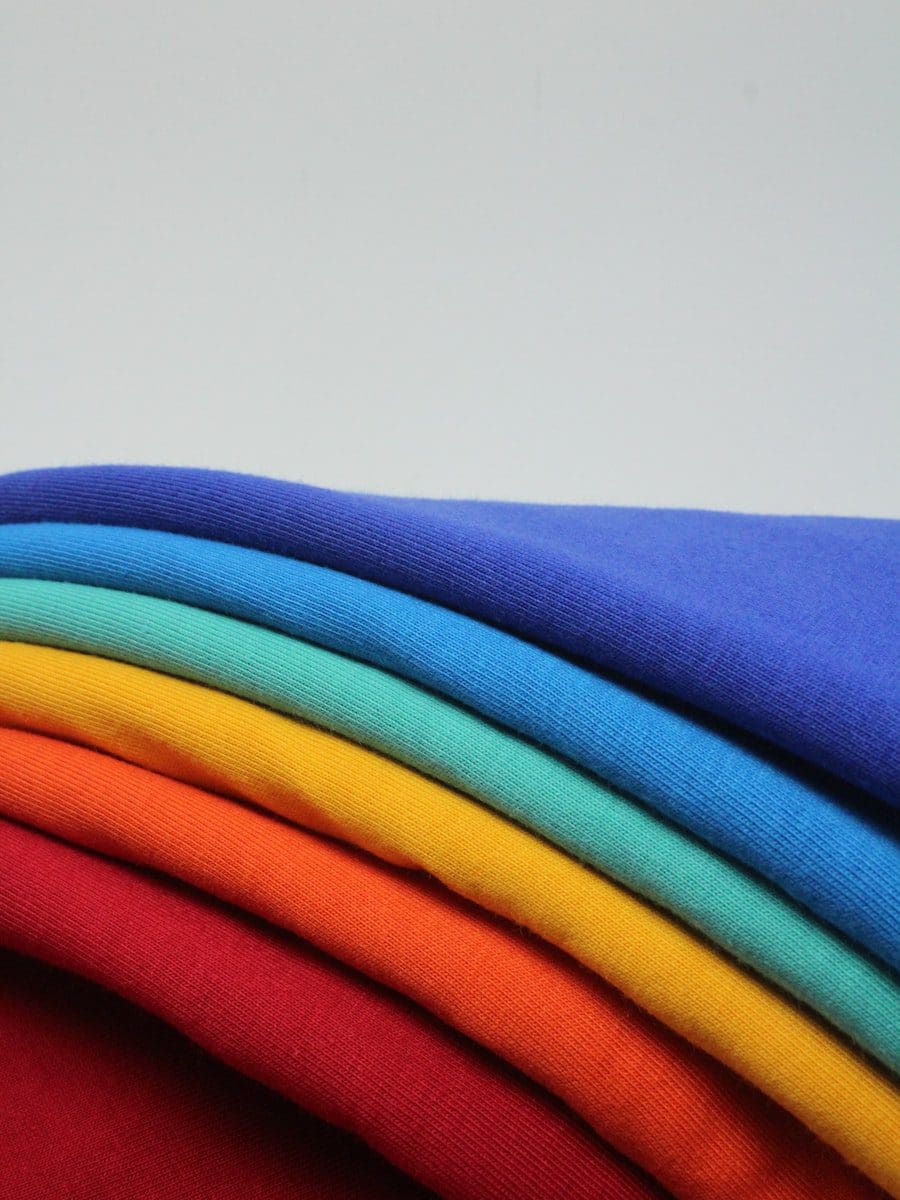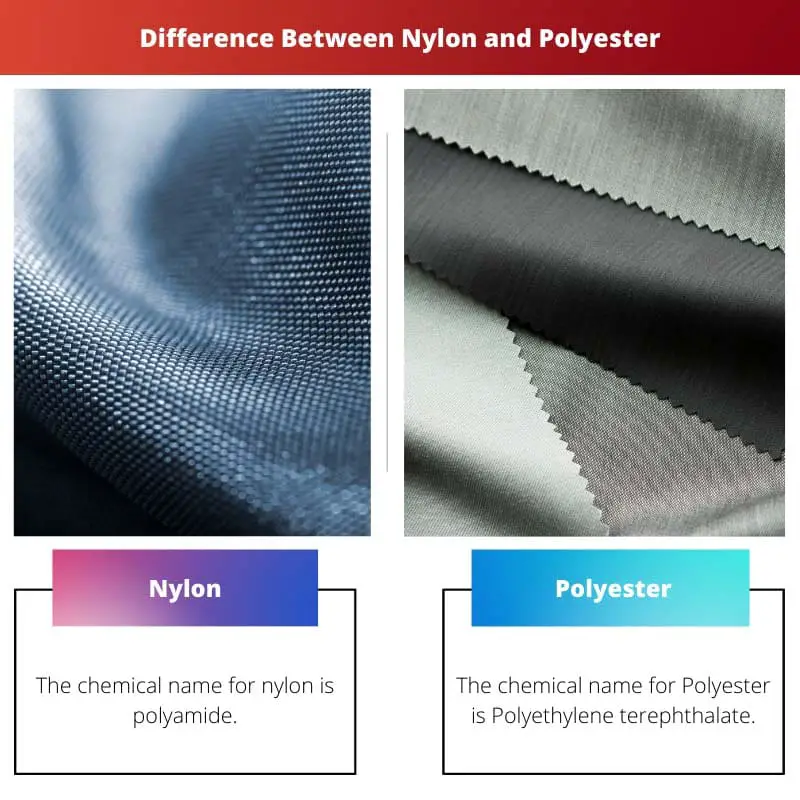Nylon and polyester are both lightweight, wrinkle-resistant, and durable synthetic fibres that are easy to be maintained and are shrinkage and stretch resistant.
They are frequently used and have several uses in our daily lives. The production of nylon is not as cost-effective as the production of Polyester.
Key Takeaways
- Nylon is softer, smoother, and has better elasticity compared to polyester.
- Polyester is more durable, resistant to UV damage, and dries faster than nylon.
- Nylon is more prone to water absorption, while polyester repels water better.
Nylon vs Polyester
Nylon is a synthetic polymer made from petroleum products. It was first developed in the 1930s as a replacement for silk in the production of stockings. Polyester is a synthetic polymer made from petroleum products. It was first developed in the 1940s and quickly became popular due to its affordability and ease of production.

Nylon is a synthetic fibre with a smooth and soft texture, yet strong. The chemical name for nylon is polyamide. It is frequently used in making daily life equipment like carpets, ropes, and clothes.
It catches fire very easily and is prevented from being used in the kitchen.
Polyester is a rough and dull-looking fabric. Its texture is being improved, but it still is no match to nylon. The chemical name for Polyester is Polyethylene terephthalate.
Like nylon, products made by polyester is also used in day-to-day life, like clothes, hats, blankets, and ropes.
Comparison Table
| Parameters of difference | Nylon | Polyester |
|---|---|---|
| Chemical name | The chemical name for nylon is polyamide. | The chemical name for Polyester is Polyethylene terephthalate. |
| Appearance | Nylon is shiny, elastic, and soft. | Polyester is dry, dull, and rough. |
| Cost | Nylon is more expensive than Polyester. | It is more cost-effective than nylon. |
| Heat-resistance | Nylon is not as reliable as polyester. | Polyester is more reliable in the heat than nylon. |
| Moisture-resistant | Nylon dries up quickly but not as quickly as polyester. | Due to its property to resist moisture, it dries up faster than nylon. |
What is Nylon?
When two big molecules like hexamethylenediamine and adipic acid are reacted together, it forms a bigger molecule, nylon 66.
Nylon is a purely synthetic fiber, unlike other semi-synthetic fibers like rayon. It is strong, elastic, and durable. It was first synthesized using basic components like coal, water, and air.
Several modifications were made later to it. But initially, it did not use any natural component like plant or animal skin.
Nylon has an important application in making things we use every day. It is used to make ropes, toothbrushes, parachutes, carpets, and clothes. It is wrinkle-free and doesn’t need to be ironed.
It has easy maintenance, has a shiny appearance, and is extremely lightweight. Though it cannot be dry cleaned, it is easy to wash and can be dried quickly.
It cannot absorb moisture. Due to this, Nylon fabric is preferred to make swimming costumes and umbrellas. In water parks, nylon clothes are only allowed to be worn by people.
It’s also more likely to be sticky or hang to the skin. It is warmer than polyester but is not used in making warm clothes that are worn in winters.

What is Polyester?
Repeating units of esters make polyester. Polyester is also lightweight, wrinkle-free, and easy to maintain synthetic fibre like nylon.
It is produced from petrol products. Some types of polyester can be nature-friendly and biodegradable, however, the majority affect global pollution. It is recyclable.
Polyesters also play an important role in making things like socks, clothes, hats, blankets, and ropes. It dries quicker than nylon. It can sometimes be dry-cleaned too.
It can catch fire easily like nylon, but it is rather more reliable. Polyester is a more long-lasting material. To soak dyes requires a lot of heat. This implies it’s a dependable choice.
They are wrinkle-free, stretch-resistant, and shrink-resistant. They’re also impervious to mould and discoloration. It can be washed easily by a regular washing machine.
It is breathable and very comfortable to wear. However, its appearance is duller and not as shiny as nylon.
Polyester is a fibre that is more dry and rough. It is more cost-effective and cheaper, as compared to nylon. It is also more moisture-resistant and water-repelling than nylon.
It is used in making brushes, pillows, carpets, and clothes. Polyester is a very important fabric, as it is a less expensive option and can sometimes replace cotton.

Main Differences between Nylon and Polyester
- The chemical name for nylon is polyamide, while the chemical name for Polyester is Polyethylene terephthalate.
- Nylon is shiny, elastic, and soft, whereas Polyester is dry, dull, and rough.
- Nylon costs more than polyester.
- Nylon can be stretched more and is long-lasting. Polyester does not have elasticity like nylon.
- Nylon is not as reliable in heat as polyester. Nylon melts after it goes to flames, however polyester melts and burns at the same time.
- Nylon and polyester both dry quickly, however, polyester is more moisture-resistant and water-repelling than nylon.

- https://journals.sagepub.com/doi/abs/10.1177/004051759506500403
- https://www.sciencedirect.com/science/article/pii/S2212982019301957

The specific applications of both nylon and polyester, such as making clothes, ropes, and blankets, illustrate the extent of their versatility and practicality in everyday life.
Absolutely, the wide range of everyday products made from nylon and polyester demonstrates their importance and widespread use in various industries.
Indeed, the diversity of products utilizing nylon and polyester highlights their significance in modern manufacturing and consumer goods.
The chemical processes involved in creating nylon and polyester shed light on their compositional differences and the resulting variations in their physical properties.
Yes, understanding the chemical composition helps in comprehending why nylon and polyester exhibit different characteristics, despite sharing some similarities.
The comparison table provided here is very illuminating. It clearly outlines the differences in chemical makeup, appearance, cost, heat resistance, and moisture resistance between nylon and polyester.
Absolutely, the detailed comparison table makes it easier to understand and remember the key differences between nylon and polyester. It’s a great reference.
The contrasting properties of nylon and polyester, from water absorption to appearance, underscore the importance of understanding the properties of synthetic fibers in manufacturing and consumer goods.
Indeed, the distinct properties and characteristics of nylon and polyester provide valuable insights into their suitability for diverse applications and industries.
The environmental impact and cost-effectiveness of polyester, in comparison to nylon, highlight the complexities associated with material choices in various industries.
Absolutely, the balance between environmental impact, cost, and performance is a critical consideration in the utilization of nylon and polyester in different applications.
Indeed, considering the environmental implications and economic factors becomes increasingly important when making decisions about material selection and production.
The detailed comparison between nylon and polyester offers a comprehensive overview of their differences, enabling informed decision-making in material selection for various products.
Absolutely, the in-depth comparison provides a clear understanding of the unique features of nylon and polyester, facilitating informed choices in material utilization.
The distinction between nylon’s softness and polyester’s durability is notable. It’s clear that each material has its own strengths and ideal applications.
Yes, the differences in texture and durability are crucial factors to consider when choosing between nylon and polyester for specific uses.
Definitely. The unique properties of nylon and polyester make them suitable for diverse products, from clothing to household items.
The historical background of nylon and polyester is insightful. Understanding their origins helps in appreciating their unique properties and applications.
I completely agree. Learning about the origins of these synthetic fibers provides valuable context for their modern-day uses and characteristics.
The distinct characteristics, such as the moisture resistance and heat resistance, provide valuable insights into the comparative advantages of nylon and polyester.
Absolutely, the unique properties of these synthetic fibers offer specific benefits in different conditions and applications.
I agree. The detailed differences in heat and moisture resistance are crucial factors in determining the suitability of nylon and polyester for diverse uses.
I find it interesting that nylon is more prone to water absorption while polyester repels water better. It’s fascinating to see the different qualities of each material.
I agree! It’s truly intriguing how each material has distinct properties that make them suitable for various applications.
Yes, the differences in moisture resistance between nylon and polyester are quite fascinating and have practical implications in everyday use.